2. GHANA
Creating awareness on the EUTR in EU
member states
A team from the Ghana Forestry Commission (GFC) visited key importers in EU
member states to exchange views and inform buyers, officials from EU
competent authorities, customs and timber trade federations on the interim
arrangements Ghana is putting in place before it is in a position to provide
FLEGT Licensed wood products.
It is expected that the arrangement being put in place in Ghana will meet
the due diligence requirements of the EUTR and will facilitate the entry of
wood product from Ghana into the EU. The GFC anticipates that FLEGT licensed
timber will be available in the first quarter of 2014.
The GFC is encouraging exporters to continue close interaction with thei
r buyers in the EU and to be ready to provide
documentation the importers may need to satisfy the EUTR.
Due diligence explained to local industry
The Ghana Forestry Commission (GFC) has organised workshops to provide
information to the timber industry and other stakeholders on the
requirements of the EUTR.
The workshop provided industry with information on the documentation that
exporters may need to provide to their customers in the EU as the importers
address the due diligence requirements of the EUTR.
Minister visits Forestry Commission
The Minister of Lands and Natural Resources, Alhaji Inusah Fuseini, has
called on the Forestry Commission (FC) to continue its partnership with the
ministry and other allied institutions to promulgate laws and regulations
which will promote sustainable forest management in the country.
The Minister made this statement when he paid his first visit to the FC
headquarters in Accra, where he interacted with the executive management of
the commission headed by Mr. Samuel Afari Dartey.
The Minister reminded the FC that the country¡¯s forest resources are a
strategic asset which needs a sustained legislative backing to guarantee its
sustainable management and utilisation.
Trimming the financial deficit
Ghana's 2013 budget aims to trim the deficit to 9 percent from the 12
percent of Gross Domestics Product (GDP) in 2012 by enhancing tax revenues
and controlling expenditures.
In his first budget statement to the nation, the Minister of Finance said
the focus in the current budget is revenue generation through expanding the
tax base and improving the efficiency of tax administration.
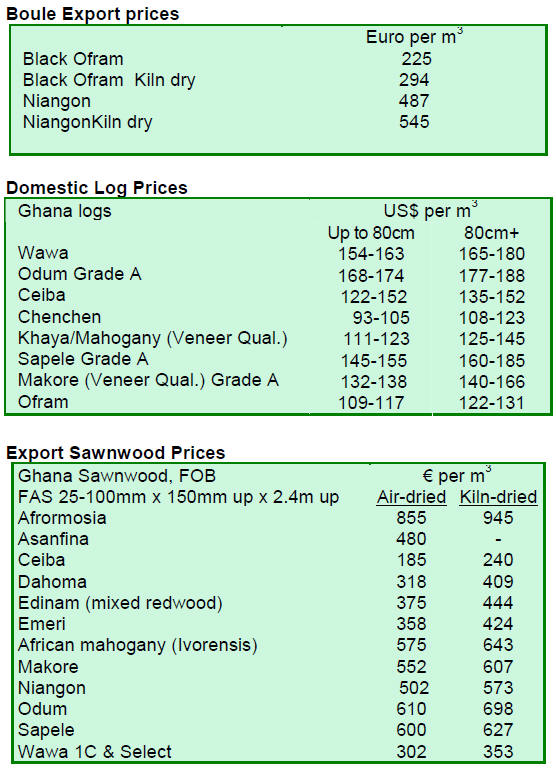
3. MALAYSIA
Growth in furniture exports to the US
Preliminary figures for Malaysian timber exports in 2012 suggest they
totalled RM 19.9 billion (approximately US$ 6.3 billion) however, the
statistics are still being finalised.
The Plantation Industries and Commodities Minister Bernard Dompok was
reported by the Star newspaper as saying the furniture sector contributed RM
8 billion (approximately US$ 2.5 billion) or around 40% of the total value
of wood product exports in 2012.
The minister emphasised the growing importance of export earnings by the
furniture sector. In 2012 Malaysian furniture was exported to 199 countries
worldwide and the value of furniture exports increased more than 4% over
levels in 2011. An almost 11% increase in furniture exports to the United
States was recorded.
New Customs regulations introduced
Kuala Lumpur regularly plays host to two international furniture fairs which
attract thousands of international buyers.
These furniture fairs come at a time when the timber industry is struggling
to meet new Malaysian regulations for exports to Europe.
As of March 2013 furniture exporters in Malaysia must apply for an export
permit from the Malaysia Timber Industry Board to satisfy revised Malaysian
Customs requirements.
The new Malaysian Customs Prohibition List applies to wooden furniture and
11 other types of wood products such as laminated scantling, flooring, etc.
The new Malaysian export regulations are aimed at providing EU importers
with credible evidence to satisfy the due diligence requirements of the EUTR.
Industry analysts are expecting exports to EU markets to dip in the short
term as Malaysian exporters gradually become familiar with the new
regulations and as information on what is required and the procedures to be
followed by exporters.
Despite the efforts of the trade associations and government agencies over
the past few months some exporters are still not totally familiar with the
new procedures.
Sabah releases export figures for 2012
The Sabah state government recently released official statistics on the 2012
FOB value of wood product exports. Plywood exports were valued at RM
1,018,134, 684 (approx. US$ 474 million), sawntimber RM 395,455,670 (approx.
US$ 126 million), mouldings RM 98,360,775 (approx. US$ 31 million),
laminated board RM 81,301,973 (approx. US$ 26 million), and veneer RM
73,335,818 (approx. US$ 23 million).
The top buyers of Sabah plywood in 2012 were Japan 21.1%, followed by
Peninsular Malaysia 18.3%, South Korea 9.7%, Mexico 9.6% and USA 8.5%.
The main buyers of Sabah sawnwood were Thailand 30.1%, followed by China
13.3%, Taiwan P.o.C 11.8%, Japan 10.8% and South Africa 9.2%.
Low log and plywood prices squeeze 2012 profits
In Sarawak, two major listed timber companies are in the news as they have
just released their financial reports. Jaya Tiasa Holdings was reported by
the Star newspaper as expecting a better year in 2013 after a weak 2012.
The company says it is optimistic that the improved housing starts in USA
and the tight log availability, which is driving up log export prices, will
help boost this year¡¯s earnings.
The company¡¯s profits fell in 2012 because the price of logs and plywood
fell by 21% and 11% respectively compared to levels in 2011.
The Star also reported on the financial reports from WK Holdings and stated
that profits were down in 2012 due to lower log production and lower than
expected income from log sales.
WTK said in notes attached to its latest financial results: ¡°Average round
log prices dropped by 7.8% and at the same time sales volume decreased by
3.4%. The Group¡¯s key export markets for round logs in 2012 were India at
79% and China (11%) while the remaining 10% was exported to ASEAN
countries¡±.
On plywood, WTK sales volume increased by 26% in 2012 but any gain from the
increase in sales volume was offset by a 7.6% drop in average prices. The
bulk WTK plywood sales (88%) were to Japan, the balance going to Taiwan
P.o.C.
¡¡

¡¡
4. INDONESIA
Debate rages on forest concession
moratorium
Officials at Indonesia¡¦s Forestry Ministry have said the country should
continue with its ban on the issuance of new forest concessions to fully
participate in international efforts on climate change mitigation.
However, the proposal to extend the government moratorium on granting
concessions, which comes to an end in May, is being opposed by some who say
the extension of the ban will hurt the economy.
National media reports say that some Indonesian politicians are calling for
a freeze on the Reforestation Fund if a decision is made to continue the
moratorium.
The challenge to continuation of the moratorium is being supported by the
Agriculture Ministry and the palm oil and mining sectors that fear this is a
business unfriendly policy which risks weakening economic growth.
The Agriculture Ministry would prefer, say media reports, to see stricter
enforcement and new controls to protect peatland and primary forest areas
rather than a ban on concessions.
A coalition of non-governmental environmental organizations has also entered
the debate urging the government to remain firm in its commitment to protect
the forests of Indonesia and uphold its commitment to reduce green house gas
emissions by between 26 percent and 41 percent by 2020. The NGOs say that if
the moratorium is not extended this goal cannot be achieved.
Several publications by the Center for International Forestry Research (CIFOR)
also call for extension of the policy and document benefits that the policy
has already brought.
International Furniture and Craft Fair Indonesia
The 2013 International Furniture and Craft Fair Indonesia (IFFINA) was held
in Jakarta from March 11-14. The four-day fair featured over 500 domestic
and overseas exhibitors.
The organizers expect business deals worth around US$400 million to be
concluded this year.
Indonesia¡¦s 2012 furniture exports grew over ten percent to around US$2
billion on the back of improved demand in US and European markets.
Speaking at the event the Industry Minister said last year¡¦s exports to the
US were worth over US$500 million while sales to Germany and the Netherlands
were around US$200 million each.
Analysts remarked that demand was initially coming from the furniture
replacement segment of the US market but, as US housing growth is expanding,
demand is now also coming from the new home furnishing segment of the
market.
To achieve growth in Indonesia¡¦s furniture exports the government has
indicated it will assist exporters seeking to diversify further into new
markets in India, China and emerging economies in South America and Africa.
ASMINDO to assist members enter new markets
Commenting on the response of buyers at IFFINA a spokesperson from the
Indonesian Furniture Industry and handicraft Association (ASMINDO) said
that, because there was a 30 percent rise in the number of buyers visiting
the fair especially those from non-traditional markets, an improvement in
the export performance of the sector seems assured.
ASMINDO intends to work with its 700 members to plan penetration of
non-traditional markets in South America and Africa without abandoning
opportunities which have recently been created for Indonesia furniture in
China, Malaysia and South Korea.
In other news ASMINDO is undertaking training on internal tracking for
members in the Solo area to strengthen the capacity of members as they apply
for the external audit required before enterprises can secure the timber
legality license (SVLK).
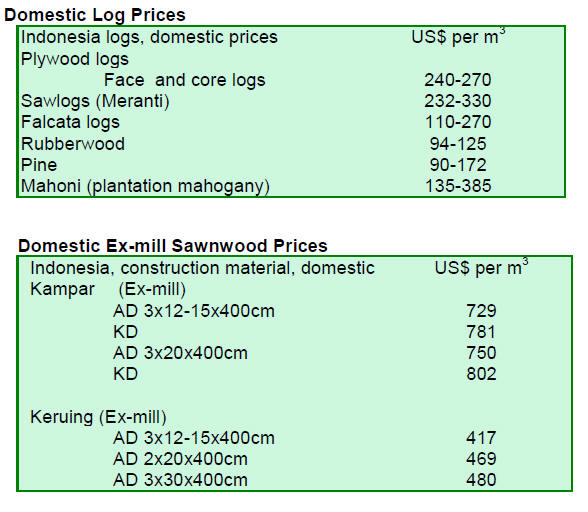
5. MYANMAR
Firm and stable market demand for teak
The market situation remains the same as reported throughout the first
quarter of 2013. Teak market is firm and there is good demand for fresh cut
hardwood (i.e. non-teak) logs. It is expected that business will remain
steady for the next few months.
Household use of wood fuel the cause of deforestation
The Myanmar Weekly Eleven, a local journal, reported that Forestry Minister
U Win Tun said Myanmar is one of the countries in the region where the rate
of deforestation is the highest, adding that the major cause is illegal
cutting for household fuelwood and charcoal production.
Association and ETTF to undertake legality assessment
The Joint Secretary of the Myanmar Timber Merchants Association U Bar-Bar
Cho has been quoted as saying the association is working with the European
Timber Trade Federation (ETTF) to agree a MOU for an independent assessment
of the systems in place in Myanmar to ensure that all timber is legally
harvested.
The MOU is being developed in response to the introduction of the EUTR.
Myanmar intends to demonstrate that it has adequate systems to ensure
compliance with the criteria for ¡®Due Diligence¡¯ thus ensuring access to the
EU market. The Myanmar industry is optimistic that an agreement can be
worked out in the coming months.
Exporters mull abandoning EU market
It has been reported in the domestic press that some timber industrialists
say they may cease timber export to the EU preferring to concentrate on
sales to countries where timbers from Myanmar are used to satisfy local
market demand rather than for re-export to EU markets.
Several Myanmar timber merchants have expressed the view that, due to the
growth in domestic demand, even if log exports are banned the country may
soon have little excess wood products to export.
On the other hand other analysts point out that, though log exports are no
longer a major foreign exchange earner, the industry is still an important
source of foreign exchange and provides thousands of jobs.
¡¡
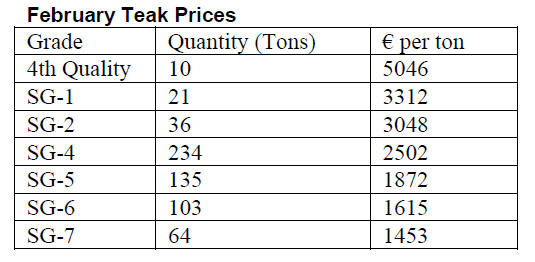
6.
INDIA
Budget offers support to home buyers
The budget for 2013-14, presented by the Finance Minister Mr.P.Chidambaram,
has not increased import duties on wood in the rough, sawn timber, plywood
and other panel products.
The good news in the budget for the timber industry is that it provides
support for home buyers. This should give a boost to the housing sector
which is a significant market for wood products. The assessment of analysts
is that the budget is well balanced and will stimulate investment.
Timber Processing Zone experiment a success
To prevent illegally felled domestic logs entering the supply chain all wood
working industries are required to obtain clearance from a ¡®Central
Empowered Committee¡¯, whose task is to verify the source of the logs.
This is a time consuming and costly process for the timber industry and
discourages new investment in wood based enterprises.
To ease the burden on industry and minimize the bureaucracy, an experiment
has been launched. A Timber Processing Zone has been created where
enterprises can be established to process only imported logs, sawnwood and
veneers.
The first such processing zone was developed in Kandla, home to a major port
servicing the timber industry on the west coast of India in the state of
Gujarat.
The procedures for establishing a wood processing plant in the Zone have
been made easy to encourage companies to invest in processing capacity.
The indications are that this experiment proved a success as about 1,000
factories of various types and sizes have been established in and around the
Zone.
The technical and marketing advantages of such a cluster of wood processing
industries are now being felt and employment opportunities have expanded.
Given the positive experience in Kandla, Paradeep Port on the east coast of
India in Odisha state has been selected for establishment of a second Timber
Processing Zone.
The government of Odisha has identified land for this project and
construction planning is underway.
IKEA investment in retailing outlets likely to get approval
The Swedish company IKEA has submitted a proposal to the Indian authorities
for investment in retail sales outlets across India for its home and office
furnishing products.
Media reports indicate that the Foreign Investment Promotion Board has
recommended IKEA¡¯s proposal to the Cabinet Committee of Economic Affaires.
India¡¯s foreign investment rules require a mandatory sourcing of at least
30% of the value of goods sold in India from domestic small and medium
enterprises.
When the IKEA investment goes ahead it could boost sales of locally
manufactured panel products, hardwood products and handicrafts.
Strong demand for imported teak despite quality issues
The availability of imported teak and other hardwoods has improved since the
beginning of the year and this has meant companies have been able to
maintain healthy stock levels.
However, analysts say hardwoods from domestic forests are preferred by
industry as the quality is better.
Teak and other hardwood logs from Myanmar are of larger girth than imported
plantation teak logs but the availability of high quality teak from Myanmar
is said to be declining.
However, due to the scarcity of domestic teak logs even poor quality logs
from Myanmar are purchased immediately on arrival at Indian ports.
Only option - switch to SE Asian hardwood alternatives
In the absence of large quantities of Haldu (Adina cordifolia), Laurel (Terminalia
tomentosa), Sal (Shorea robusta),Bija (Pterocarpus marsupium) end-users have
been switching to Balau, Rengas, Meranti, Merbau and Kempas from South East
Asia. There is a firm demand for these timbers in India.
Imports of Radiata pine help meet the shortage of local species for
production of boxes and crates, pallets and for concrete shuttering. The
flow of Radiata shipments from New Zealand is steady and prices are stable.
Active trade in imported plantation teak
Supplies and shipments of imported plantation teak logs and squares are
steady and prices remain unchanged. The trade in imported timber is very
active due to the shortage of local hardwoods.
Prices C & F Indian ports, per cubic metre are shown below.
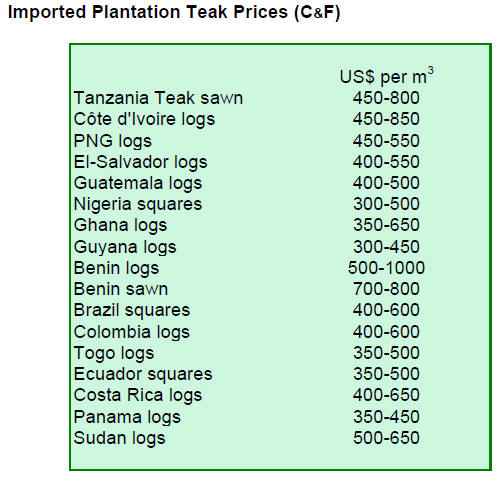
Variations exist based on lengths and average girths of logs in a parcel.
Prices also vary with measurement allowances given for bark and sap in
different countries of origin.
Domestic sawnwood prices
Prices for air dried sawnwood remain unchanged. Prices are shown below as
per cubic foot, ex-sawmill.
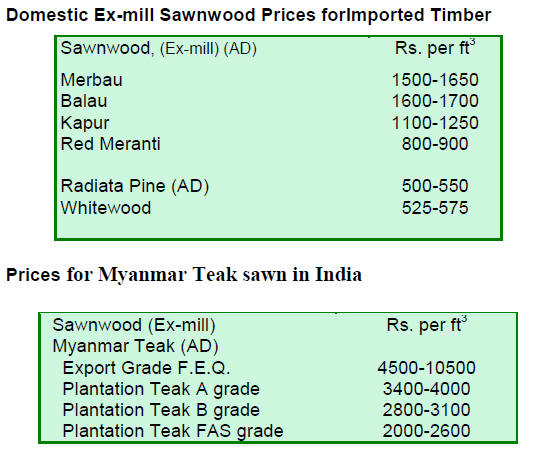
The price range is the result of variations in length and cross section.
Prices for imported kiln dry (12% mc) sawnwood
Prices remain unchanged.
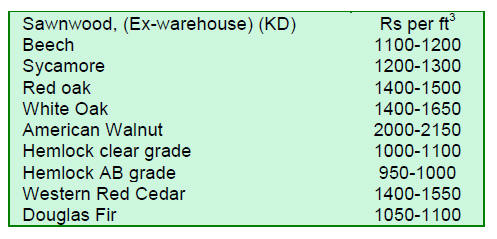
Plywood manufactures undeterred by Chinese
plywood imports
The level of taxes and stamp duty on newly built homes continues to deter
prospective home buyers and this affects the timber sector, especially
plywood and other woodbased panel manufacturers.
Imports of plywood from China continue but as the quality is perceived as
low such imports are not seriously affecting sales of domestically made
plywood.
Current market prices are shown below.
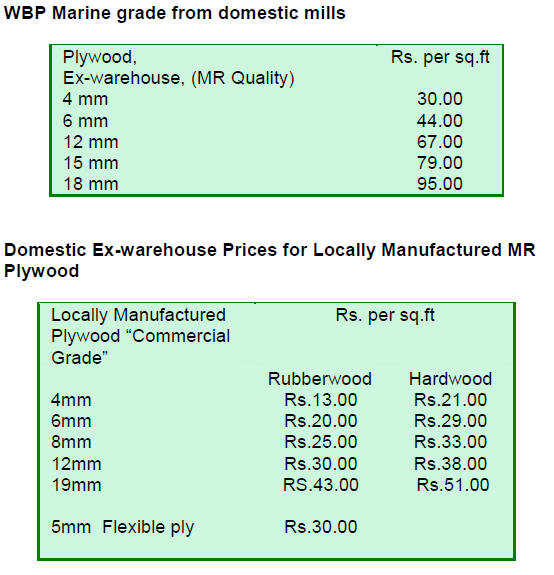
7.
BRAZIL
Domestic price trend puzzle because
of Real/US$ exchange rate
On the domestic market wood product prices in Brazilian reals have increased
by an average 2.0% over the past three months.
However, average prices, in US$ shown in the tables below, illustrate that
in dollar terms there has been a downward movement in prices of 3.9%. This
is due to the appreciation of the Brazilian currency against the US dollar
during the period reported.
New Forest Concession in Rondônia State
The result of competitive public bidding for forest concessions in the
national forest of Jacund?in the state of Rondônia (Jacund?FLONA ) was made
public by the Brazilian Forest Service (SFB) on March 5, 2013.
The Madeflona Industrial Wood Company won the bid for forest management
units (FMUs) 1 and 2, covering 55,000 and 32,700 hectares, respectively.
The forest concessions available also included a third FMU of 23,600
hectares, but there were no bids from qualified candidates for this FMU.
There were a total of 11 bids for the available concessions and the bids
were opened in public to ensure transparency in the selection of
concessionaries.
With the completion of the allocation process the next step will be the
signing of concession contracts. Each concession agreement is valid for up
to 40 years for the sustainable harvesting of timber and non-timber
products.
The JacundaFLONA is the second national forest in which harvesting
concessions have been made available in Rondoia state.
IBAMA Seizes illegal timber in Para state
Inspectors of the Brazilian Institute of Environment and Renewable Natural
Resources (IBAMA) seized 8,000 cubic metres of illegally harvested timber in
an area 200 kilometres from the city of Santarem, in the Par?state, in the
Amazon region.
The volume seized is equivalent to about 320 truckloads of logs. This
seizure was the result of one of the first operations of IBAMA in this state
in 2013.
Part of confiscated timber will be transported by the Civil Defence Force
but, because of access problems, some logs will be destroyed where they have
been stored after seizure.
In regions monitored by IBAMA, inspection teams have located illegal log
storage sites and have removed illegal logging camps and seized boats that
were used to transport illegal products. This year five clandestine loading
points were shut down.
In the state of Mato Grosso IBAMA inspectors are working with security force
troops to ensure greater surveillance. IBAMA says that with the help of the
troops it will be able to double the number of inspection teams in the
region.
Satisfying EU requirements on legal origin
According to ABIMCI the EUTR, which requires proof of origin of the wood raw
materials used to manufacture products, will not affect trade from Brazil as
Brazilian entrepreneurs comply with requirements on the legal origin of
timber.
ABIMCI reaffirmed that there is no illegal timber or wood products being
exported from Brazil.
The EUTR, says ABIMCI, could result in a marketing advantage for Brazilian
exporters as some of its competitors?in the European market may find it
difficult to meet the requirements of the EUTR.
Europe is the main destination for Brazilian wood products. In 2012, Europe
purchased 65% of exported plywood.
ABIMCI is working with the timber associations in Europe as well as the
European Timber Trade Federation and other federations in the EU member
states to provide information on the capacity of Brazilian exporters to
satisfy the new EU legal requirements.
International funds to preserve forests not reaching Brazil
A recent analysis of the flow of funds for forest conservation shows that
only around 39% of the US$ 597 million pledged by four private foundations
and five government agencies were disbursed during the period 2009 to 2012.
Most of the funds reportedly went to NGOs and government agencies for three
purposes; support for projects on Reducing Emissions from Deforestation and
Forest Degradation (REDD+), empowering communities and for developing new
national policies.
Despite the low level of funding for practical conservation, the flow of
funds in Brazil is said to be higher than other countries that also have
REDD+ programmes. The flow of funding is said to be as low as 18% in
Vietnam, 3% in Ghana and just 1% in Ecuador.
The main reasons cited for the slow flow of funds are excessive bureaucracy
in the recipient countries and the poor capacity of recipient organizations
to manage the funds in an open and transparent manner.
It is pointed out by analysts that the lack of a clear regulatory framework
for REDD projects in Brazil makes disbursement of development funds
difficult.
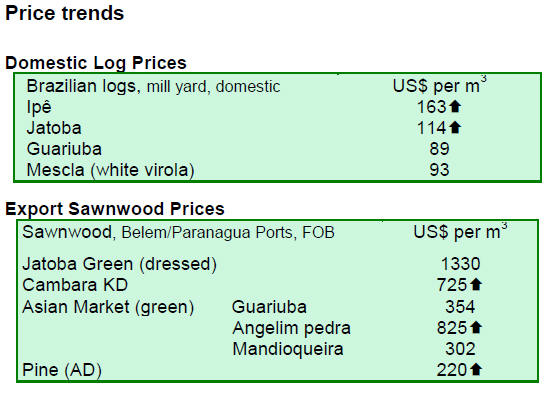

¡¡
8. PERU
2012 trade figures from ADEX
The Exporters Association of Peru (ADEX) has just released 2012 wood product
export statistics. The cumulative FOB value of exports by the timber sector
was US$164.8 million down 2.5% on 2011.
In 2012 the three main wood export destinations were China, Mexico and
United States and these three markets accounted for 72.5% of all sector
exports. Growth was recorded in exports to the USA, Dominican Republic and
France, much of this growth was from increased sales of parquet.
Among the markets that weakened during 2012 were China, down 11% and Mexico,
down 12%.
2012 Sawnwood and plywood exports grew in an otherwise slow market
The FOB value of sawnwood exports in 2012 was just over US$66 mil.,
representing 40% of all exports. In contrast to the export performance of
other products, sawnwood sales increased 14% from US$58 mil. in 2011.
The single most important market for sawnwood from Peru was Mexico, a market
that accounted for around 31% of all 2012 sawnwood exports.
Exports of semi-manufactured wood products earned US$56.3 mil. in 2012 but
were down around 19% on levels in 2011.
The main destination for semi-manufactured products was China which
accounted for 60% of all sales. Encouraging signs were seen in demand from
Belgium for semi-manufactured products in 2012.
Exports of veneer and plywood in 2012 were worth US$ 22 mil. FOB, this
represented an increase in earnings of US$2.4 mil. or almost 13% over levels
in 2011. Mexico accounted for most (58%) of the veneer and plywood exports
from Peru in 2012.
The exports of furniture and furniture parts fell in 2012 to US$ 7.5 mil.
FOB, down 9.7% compared to 2011. The US was the main market accounting for
57% of exports followed by Italy (21%).
¡¡
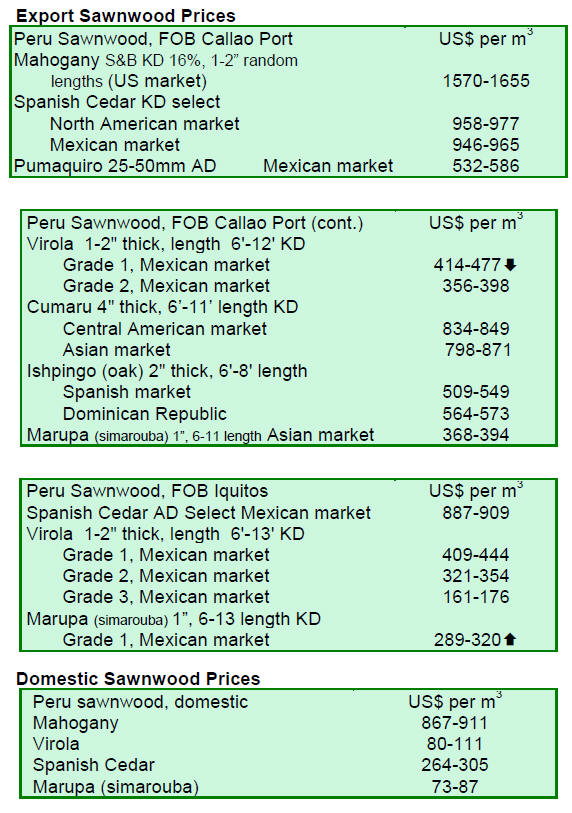
9.
GUYANA
Log market quiet but sawnwood market
active
In the period reviewed there were no exports of greenheart or mora logs.
Standard sawmill quality purpleheart logs were exported but at lower prices
than recorded recently.
Standard sawmill quality purpleheart log prices dropped from US$385 to US$
350 per cubic metre FOB.
While the log market was quiet, active business was seen in sawnwood export
markets but, as for the log market, some prices weakened.
Shippers of greenheart (undressed, select) experienced a decline in top end
price from US$950 to US$912 per cubic metre FOB. Greenheart (undressed,
merchantable) sawnwood prices were around average in the region of US$636
per cubic metre FOB.
In contrast, purpleheart (undressed, select) sawnwood prices held firm at
US$1,100 per cubic metre FOB, marginally better than levels recorded
recently.
Export prices for purpleheart (undressed, merchantable quality) moved as
high as US$650 per cubic metre FOB. Mora sawnwood was not exported in the
period reviewed.
Dressed Greenheart sawnwood top end FOB prices improved significantly,
moving from US$1,060 to US$1,500 per cubic metre FOB. The main markets for
dressed greenheart sawnwood were Asia and the Caribbean.
Dressed purpleheart sawnwood prices were encouraging at around US$1,102 per
cubic metre FOB.
Plywood, shingles and piling dominate added value exports
Plywood export prices have weakened slightly recently. BB/CC quality plywood
was traded at US$584 just US$5 lower than for the previous two week period.
Splitwood (shingles) prices remain at attractive levels and the main markets
are the Caribbean and Middle East.
Round (piling) prices were favourable on the export market moving to as much
as US$651 per cubic metre FOB for the markets in Europe and North America.
External funding for CoC and LUS promotion
The Forest Products Development and Marketing Council of Guyana (FPDMC) has
received external funding to support marketing, promotion and product
development of Guyana¡¯s timbers within the forest sector.
One of the major aims of the Council is the strengthening of the timber
industry in Guyana through developing strategic marketing plans.
A key activity of the Council will be the production of a promotional video
targeting the local and overseas consumer. The aim in producing the video is
illustrate all aspects of the chain of custody controls from harvesting to
export of value added products.
The FPDMC will include in its plan further awareness raising and promotion
for domestic and overseas consumers of the opportunities offered by Guyana¡¯s
lesser used species.
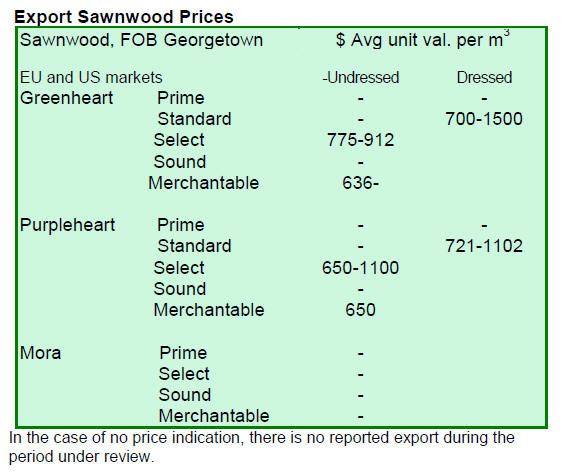
¡¡
¡¡